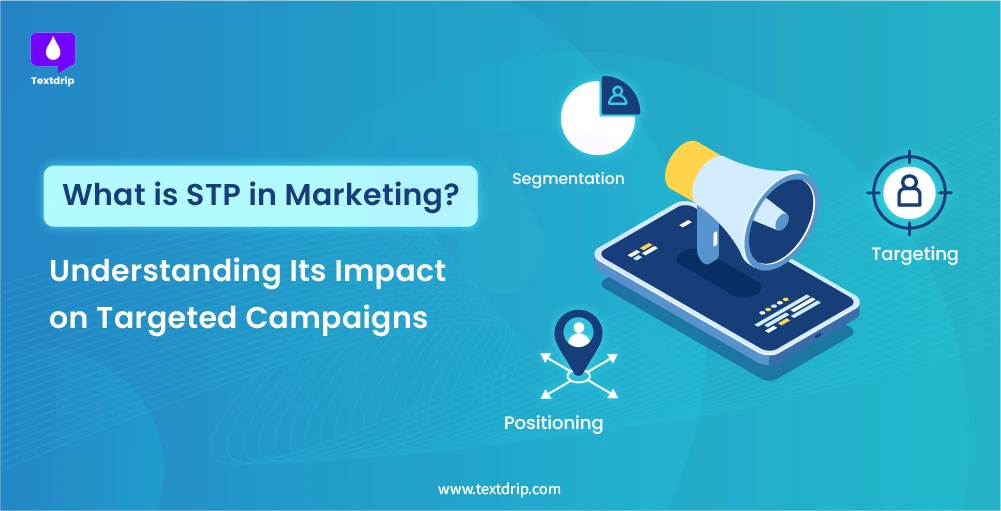
01 Oct 2024

Dhimant Vyas


01 Oct 2024

Dhimant Vyas
Have you heard this common saying? –
“Don’t try to be Everything to Everyone, else you will become Nothing to Anyone.”
The same applies to the business world. Most businesses try to position their products in a way that benefits everyone. With this approach, they cast their net and spread it wide enough, hoping to catch enough customers soon. However, here they are mistaken. This approach has two significant flaws.
Let’s understand it with a simple scenario.
You have built an extraordinary product, such as SMS marketing platform like Textdrip, to solve a specific problem – effective customer communication. However, think about it—will the global population have the same problem? Even if you have built an essential product, it must stand out. Otherwise, you won’t be able to bring the desired sales.
For that, you need to segment and target the right audience and position your product so well that your target audience wants to buy it. Here is where STP marketing comes into the picture.
This article explains what STP is in marketing and how it affects the targeted SMS marketing campaigns with STP marketing examples.
STP stands for segmentation, targeting, and positioning. It is the three-step, customer-centric approach to all marketing communications that helps you make data-packed decisions. As a business owner, you must understand that not all customers have uniform needs. With the STP model, you can redefine to whom and how you want to market your product. It will make your marketing communication more relevant, focused, and tailored for your customers.
In STP marketing, you need to divide the broader target audience market into specific groups according to specific attributes. After that, you need to select the most relevant and attractive segment and craft the SMS marketing campaign that speaks directly to them.
Let’s make it simple through this example.
You must have heard about HubSpot. The platform needs no introduction. HubSpot segments its audience based on business size and industry needs. Preliminary targets SMBs – small to medium businesses that need a platform that offers marketing automation, sales CRM, and customer service. HubSpot positions itself as an all-in-one solution for inbound marketing. They craft a message that perfectly resonates with their target audience. Doing so will get better customer engagement and higher conversion rates.
In short, the STP marketing approach is imperative to get the desired results. As the SMS Marketing Statistics and research shows, 91% of customers prefer buying from brands that provide tailored and relevant offers. In addition, 80% of customers love buying from brands that offer personalized experiences.
STP marketing helps in defining the target market and audience. Therefore, brands can easily step up their sales. This marketing approach offers the following benefits.
Now that you know what STP marketing is and its benefits, let’s understand this model in detail.
Segmentation means dividing your target audience into smaller groups according to their specific characteristics. This process lets you group potential customers into smaller groups so that you can communicate your products, features, and benefits to the people for whom they are more relevant.
Here are a few criteria based on which you can segment your audience. You can segment your audience based on one or more than one criteria.
Let’s understand it through a simple example.
Suppose you have built an SMS marketing tool. The tool offers various services like SMS Automation, two-way texting, bulk messaging, etc. Now, to better understand how to position your service, you can split your audience into the following segments.
The message that you craft for each segment will be different. You can collect this data through feedback, interviews, surveys, social media, website analytics, marketing automation, etc. Based on the data, you can run more relevant campaigns to specific segments.
Segmentation is followed by targeting.
Once you have your audience segment, it’s time to target them. However, you need to first decide which segments are worth targeting. If you have been in the business for some time, it is not hard to find out which segment will be more profitable for you.
You can even opt for a different approach and use the following data points to decide the ideal segment.
Here you need to remember to compare your customer acquisition cost – CAC with profitability. Don’t choose that segment if the CAC is too high compared to profit.
Generally, businesses use the following kinds of targeting strategies after the segmentation.
Certain frameworks like PESTLE can also help you understand which external factor would impact your target audience’s opinion. In this framework:
P = Political
E = Economic
S = Social
T = Technological
L = Legal
E = Environmental
Apple is a well-known brand that targets premium customers who are willing to pay for quality, innovation, and design. They target professionals who are in creative fields, tech-savvy individuals, and people who value their integrated ecosystem.
The final step of the STP model is positioning, which means defining why and how your product/service is different from your competitors and positioning your product/service as the best option in your chosen segment’s mind.
Simply put, segmentation and targeting are all about customers. However, positioning is all about your product/service and that also from customer’s perspective. In short, positioning is that bridge which connects your product with the audience. In this stage, you need to perform competitor analysis, find value propositions, and effectively communicate them with your customers.
There are three main factors that help you position your brand.
The symbolic positioning improves the self-confidence, image, or ego of your customers.
Do you know which industry is the best example of it? – Luxury Car Industry. When customers own luxury cars, their confidence and image are automatically boosted.
Another factor is functional positioning, which helps solve customers’ issues and offers them genuine benefits.
You can position your brand based on the emotional connection customers have with your product, service, or brand.
Here are the main components that help in brand positioning.
| Factors | Components |
| Functional Positioning | Product features like quality, value for money, reliability, etc. |
| Symbolic Positioning | Branding elements like slogans, taglines, logos, and brand messaging evoke specific feelings or aspirations. |
| Experimental Positioning | It incorporates all interactions that customers have with the brand, such as customer service, user experience, and overall satisfaction. |
However, keep in mind that the most successful brand positioning is the one that combines all three factors.
Many famous US brands use the STP model to personalize their marketing efforts. Here are some well-known brands that use this model effectively.
The STP model can be highly effective and drive your desired results with targeted marketing campaigns.
How?
In segmentation, you will break down your audience into specific segments so that you can concentrate on the right audience. In short, instead of going for the one-size-fits-all approach, you are creating tailored messages that directly address each segment’s needs, interests, and behaviour.
Targeting lets you zoom in on the picture and concentrate on the most profitable and relevant segment for your product/service. Therefore, your marketing efforts won’t be wasted on people not interested in your product/service. With the right segment targeting, you will be able to hit the sweet spot of people who are genuinely interested in buying your product/service.
Positioning will allow you to communicate your brand’s voice effectively with your chosen segment. Due to this, you will experience increased engagement, higher conversion rates, and improved ROI.
In short, with the STP model, you can craft campaigns that help you connect with your target audience on a personal level. It will transform your lead into loyal customers.
In a nutshell, STP marketing is a tried-and-tested marketing approach that will help businesses connect with their audience more meaningfully. By using it, businesses can identify the right segment, target the right audience, and position their product/service where they can provide value and earn profits.
Through the STP model, you can better target your marketing messages by understanding your audience well. Your customers will also get what they are looking for. In short, it is a win-win situation for both of you!
Your marketing messages will become more relevant and impactful and drive you long-term growth. SMS marketing platforms like Textdrip also help you segment and target the right market and position your brand well with their unique features like personalization, contact segmentation, drip campaigns, SMS automation, schedule messages, etc. Contact us today for the free trial, or you can book a demo to try it yourself.
STP stands for Segmentation, Targeting, and Positioning. It’s a framework used to identify and reach specific customer groups effectively.
Traditional marketing often uses a one-size-fits-all approach, while STP focuses on customizing messages for specific audience segments to improve relevancy.
Segmentation can be based on demographics (age, gender), geographic location, psychographics (lifestyle, values), or behavioral factors (purchase history, brand loyalty).
Choosing the right target involves analyzing each segment’s potential profitability, accessibility, and alignment with your product or service.
Common strategies include emphasizing product quality, price advantages, unique features, or emotional benefits that resonate with the target market.